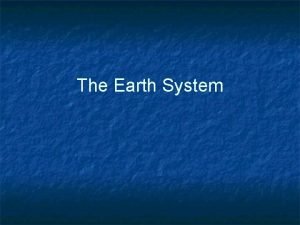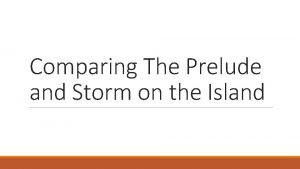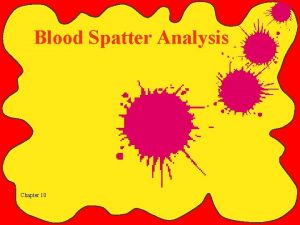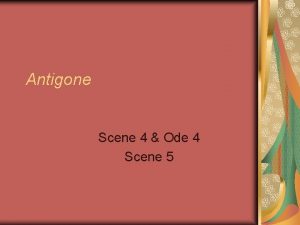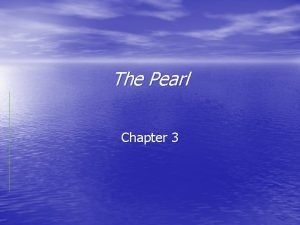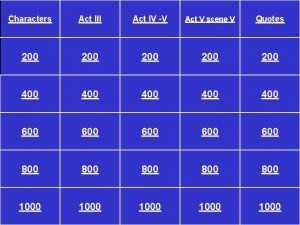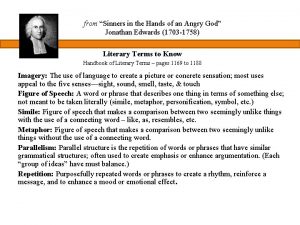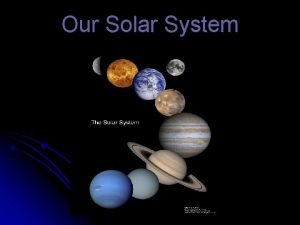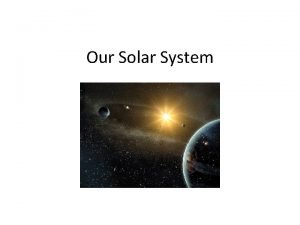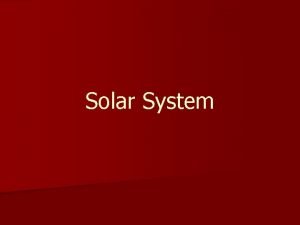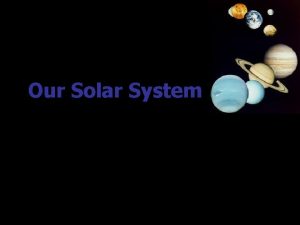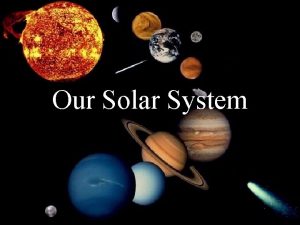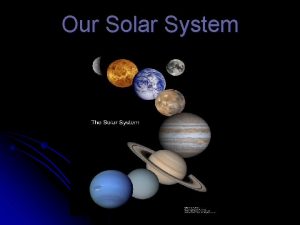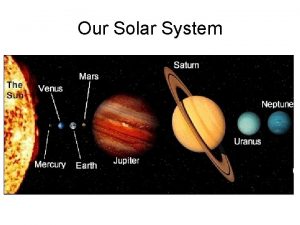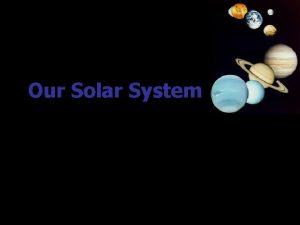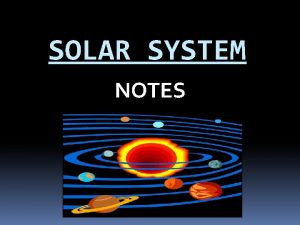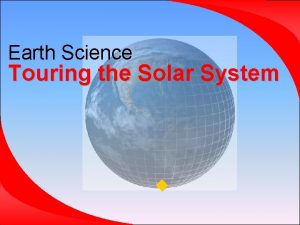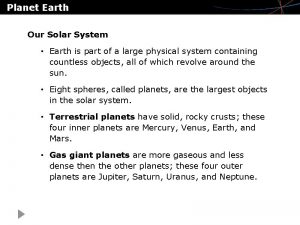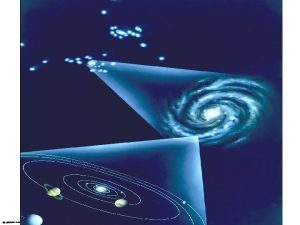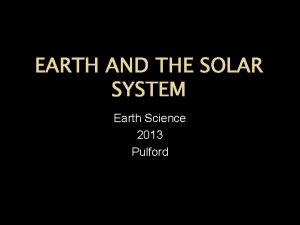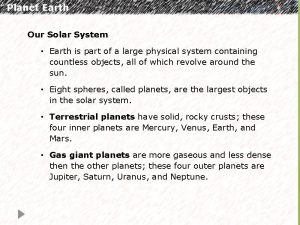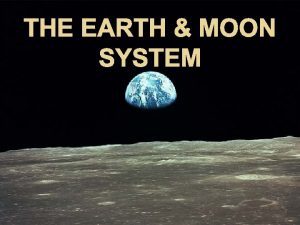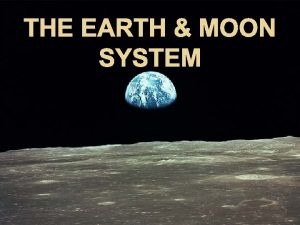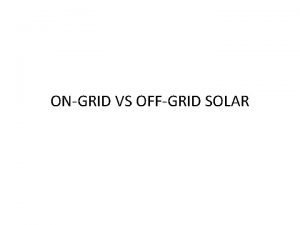The Solar System How does Earth compare to





































![Relative Size Demonstration [see resources] Relative Size Demonstration [see resources]](https://slidetodoc.com/presentation_image_h2/2f5db70dbf337aaccd18769350e92b03/image-38.jpg)
- Slides: 38

The Solar System

How does Earth compare to other planets in the solar system? S 6 E 1 c. Compare and contrast planets in terms of: size relative to earth; surface and atmospheric features; relative distance from the sun; ability to support life S 6 E 1 e. Explain that gravity is the force that governs the motion of the solar system

Use the Solar System Planet Notes to record important information.

Gravity • The gravitational force of the Sun keeps planets in orbit around the Sun and controls the rest of the motion of the solar system. • The mass of an object and the distance between objects determine the force of gravity. Inertia and gravity work together. • The gravitational attractions of the planets, either individually or as a group are small because of the distances between the planets.

Distances between planets in the Solar System animation http: //www. classzone. com/books/earth_science/terc/content/visuali zations/es 2701 page 01. cfm? chapter_no=visualization

Study Jams Video: Gravity & Inertia

Turn to a seat partner and discuss the following: What would happen to the planets or any object in the universe if gravity did not exist?

The Solar System • Revolution (revolve) is orbiting around another body • Planets in our solar system revolve around the sun in elliptical (oval) orbits. http: //www. solarsystemscope. com/ http: //lasp. colorado. edu/education/outerplan ets/orbit_simulator/ • The planets in our solar system differ in size, composition (rock or gas), surface and atmospheric conditions, and distance from the sun.

The Solar System • The planets are divided into two groups – The inner planets are smaller, closer to the sun, and have rocky surfaces (Mercury, Venus, Earth, Mars) – The outer planets are larger, farther from the sun and do not have solid surfaces (Jupiter, Saturn, Uranus, Neptune)

The Solar System We will be examining the planets in the Solar System based on a few main characteristics: • • • Size relative to the earth Surface features Atmospheric features Relative distance from the sun Ability to support life Other facts Let’s make sure you understand the meaning of these characteristics

Size Relative to Earth… “Relative to” means the same as “in Comparison with. ” Let’s look at some examples. Get with an elbow partner. • The size of your foot “Relative to” an elbow partner’s foot. [Hint: is it larger or smaller? ] • The size of your science textbook “Relative to” the size of a library book or another book. • The size of your pencil “Relative to” the size of your elbow partner’s pencil.

Surface features…

Atmospheric features… Atmosphere is defined as the mass of gases surrounding a planet. Atmospheres can consist of many different gases. These gases cause different atmospheres on planets.

Relative from the Sun… “Relative to” means the same as “in Comparison with. ” Let’s look at some examples. Get with an elbow partner. • The “Relative distance” of your classroom to the office of the school versus the “Relative distance” of the cafeteria to the office of the school. [Hint: is it longer or shorter? ] • The “Relative distance” of your house to the mall versus the “Relative distance” of your house to Atlanta.

Ability to Support Life… Let’s look at some characteristics that scientists believe are necessary for life on a planet. http: //hubblesite. org/hubble_ discoveries/discovering_pla nets_beyond/alienatmospheres [look at earth not alien]

Turn to a different elbow partner and together identify the main characteristics that we will discuss about the planets in our solar system. Be prepared to share if called upon.

Use the Planet Comparison Chart to take notes about each Planet in the Solar System.

Mercury

Mercury • Size relative to earth: smaller than earth • Surface features: many craters and high cliffs • Atmospheric features: no atmosphere • Relative distance from the sun: closest planet to the Sun • It cannot support life • Other facts: Inner planet; has no moons; “earth-like” characteristics

Venus

Venus • Size relative to earth: Close to the earth’s size • Surface features: Hottest planet (can melt lead) • Atmospheric features: Contains Carbon dioxide (CO 2) • Relative distance from the sun: Second planet from the sun • It cannot support life • Other facts: Inner planet; sometimes called Earth’s twin because of its “earth-like” characteristics; a day is longer than a year due to its slow spin; spins clockwise; brightest object in the sky after the sun and moon

Earth

Earth • Surface features: Has canyons, craters, mountains, volcanoes; more than 70% of the surface is covered by water • Atmospheric features: Contains Oxygen (O 2) and Nitrogen (N 2) • Relative distance from the sun: Third planet from the sun • Only planet known to support life • Other facts: Inner planet; Has one moon

Mars

Mars • Size relative to earth: Smaller in size than the earth • Surface features: “earth-like” characteristics; all water is frozen; once had active volcanoes • Atmospheric features: Thinner atmosphere than earth made mostly of carbon dioxide (CO 2) • Relative distance from the sun: Fourth planet from the Sun • It cannot support life • Other facts: Inner planet; called the red planet because of rusted soil; has severe dust storms at hurricane speed

Study Jams Video: Inner Planets

Think, Pair, Share: Why are the first four planets generally grouped together? Turn to an elbow partner and discuss your answer. Be ready to respond.

Jupiter

Jupiter • Size relative to earth: Larger than the earth • Surface features: Gaseous planet • Atmospheric features: Contains mostly Hydrogen (H 2) and Helium (He) • Relative distance from the sun: Fifth planet from the Sun • It cannot support life • Other facts: Outer planet; largest planet; faint ring of dust; spins the fastest; has 63 moons; has a large red spot

Saturn

Saturn • Size relative to earth: Larger than earth • Surface features: Surface is fluid; it is the least dense planet • Atmospheric features: Contains mostly Hydrogen (H 2) and Helium (He) • Relative distance from the sun: Sixth planet from the Sun • It cannot support life • Other facts: Outer planet; Gaseous planet; 1 year equals 29 ½ Earth years; Largest, most impressive ring system; Second largest planet in the solar system

Uranus

Uranus • Size relative to earth: Larger than earth • Surface features: planet of ice and gas so it really does not have a surface (you would sink into the liquid icy center) • Atmospheric features: Contains mostly Hydrogen (H 2), Helium (He), and Methane (CH 4) • Relative distance from the sun: 7 th planet from the Sun • It cannot support life • Other facts: Gaseous planet; Third largest planet; Tipped on its side

Neptune

Neptune • Size relative to earth: Larger than earth • Surface features: Coldest planet and has large storm systems like the Great Dark Spot; not a solid surface • Atmospheric features: Methane (CH 4) • Relative distance from the sun: 8 th planet from the sun • It cannot support life • Other facts: Outer planet; Gaseous planet

Study Jams Video: Outer Planets

Think, Pair, Share: Why are the last four planets generally grouped together? Turn to an elbow partner and discuss your answer. Be ready to respond.
![Relative Size Demonstration see resources Relative Size Demonstration [see resources]](https://slidetodoc.com/presentation_image_h2/2f5db70dbf337aaccd18769350e92b03/image-38.jpg)
Relative Size Demonstration [see resources]
 Compare terrarium to earth system
Compare terrarium to earth system Wholesale panel solar
Wholesale panel solar Solar energy is free. solar is inexhaustible
Solar energy is free. solar is inexhaustible Compare embedded system and real time system
Compare embedded system and real time system Open closed and isolated systems
Open closed and isolated systems Venn diagram of typhoon and tornado
Venn diagram of typhoon and tornado Storm on the island comparison
Storm on the island comparison 10 degree blood drop
10 degree blood drop Who does antigone blame for her misfortune
Who does antigone blame for her misfortune The pearl by john steinbeck chapter 3
The pearl by john steinbeck chapter 3 To what does antony compare lepidus
To what does antony compare lepidus Asl slide
Asl slide How does the parallel structure build a sense of horror
How does the parallel structure build a sense of horror How does rowdy compare junior to a nomad
How does rowdy compare junior to a nomad Hát kết hợp bộ gõ cơ thể
Hát kết hợp bộ gõ cơ thể Frameset trong html5
Frameset trong html5 Bổ thể
Bổ thể Tỉ lệ cơ thể trẻ em
Tỉ lệ cơ thể trẻ em Gấu đi như thế nào
Gấu đi như thế nào Tư thế worms-breton
Tư thế worms-breton Alleluia hat len nguoi oi
Alleluia hat len nguoi oi Các môn thể thao bắt đầu bằng tiếng đua
Các môn thể thao bắt đầu bằng tiếng đua Thế nào là hệ số cao nhất
Thế nào là hệ số cao nhất Các châu lục và đại dương trên thế giới
Các châu lục và đại dương trên thế giới Cong thức tính động năng
Cong thức tính động năng Trời xanh đây là của chúng ta thể thơ
Trời xanh đây là của chúng ta thể thơ Mật thư tọa độ 5x5
Mật thư tọa độ 5x5 Phép trừ bù
Phép trừ bù Phản ứng thế ankan
Phản ứng thế ankan Các châu lục và đại dương trên thế giới
Các châu lục và đại dương trên thế giới Thể thơ truyền thống
Thể thơ truyền thống Quá trình desamine hóa có thể tạo ra
Quá trình desamine hóa có thể tạo ra Một số thể thơ truyền thống
Một số thể thơ truyền thống Bàn tay mà dây bẩn
Bàn tay mà dây bẩn Vẽ hình chiếu vuông góc của vật thể sau
Vẽ hình chiếu vuông góc của vật thể sau Biện pháp chống mỏi cơ
Biện pháp chống mỏi cơ đặc điểm cơ thể của người tối cổ
đặc điểm cơ thể của người tối cổ Thế nào là giọng cùng tên
Thế nào là giọng cùng tên Vẽ hình chiếu đứng bằng cạnh của vật thể
Vẽ hình chiếu đứng bằng cạnh của vật thể
